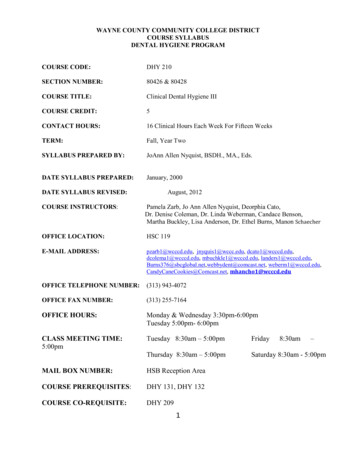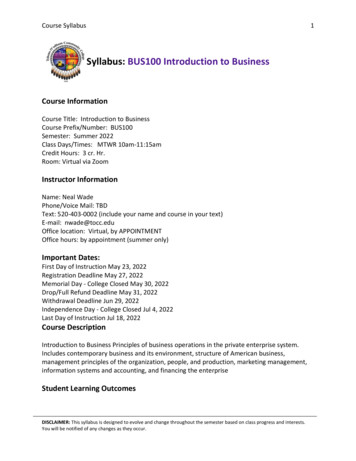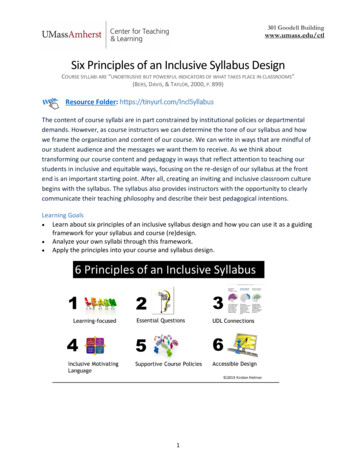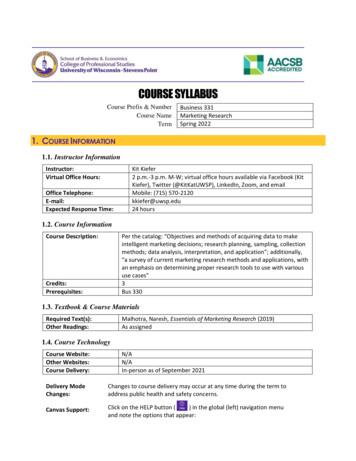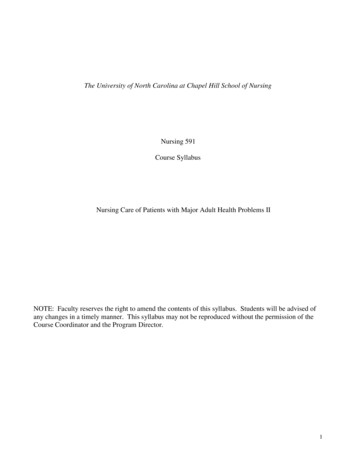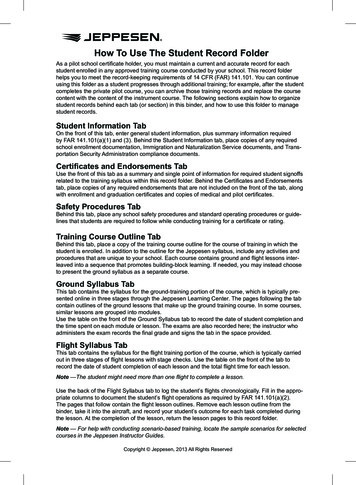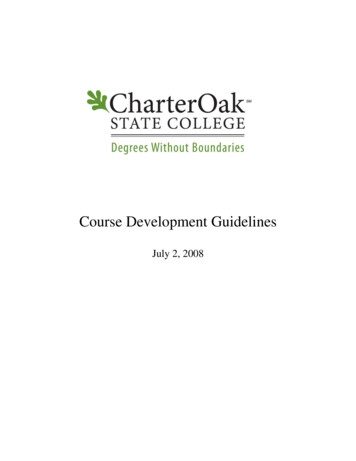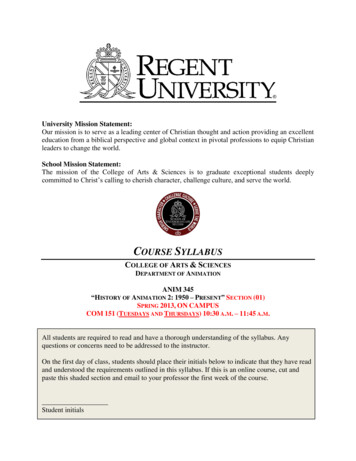
Transcription
University Mission Statement:Our mission is to serve as a leading center of Christian thought and action providing an excellenteducation from a biblical perspective and global context in pivotal professions to equip Christianleaders to change the world.School Mission Statement:The mission of the College of Arts & Sciences is to graduate exceptional students deeplycommitted to Christ’s calling to cherish character, challenge culture, and serve the world.COURSE SYLLABUSCOLLEGE OF ARTS & SCIENCESDEPARTMENT OF ANIMATIONANIM 345“HISTORY OF ANIMATION 2: 1950 – PRESENT” SECTION (01)SPRING 2013, ON CAMPUSCOM 151 (TUESDAYS AND THURSDAYS) 10:30 A.M. – 11:45 A.M.All students are required to read and have a thorough understanding of the syllabus. Anyquestions or concerns need to be addressed to the instructor.On the first day of class, students should place their initials below to indicate that they have readand understood the requirements outlined in this syllabus. If this is an online course, cut andpaste this shaded section and email to your professor the first week of the course.Student initials
SECTION 1 - OVERVIEWYOUR INSTRUCTOR FOR THIS COURSE:Instructor: Kevin R. Crawford, M.F.A., Ph.D.Telephone: (757) 647-9003Fax: (757) 352-4275Email: Kevicra@regent.eduOffice Hours: (By Appointment)Office Location: COM 250PERSONAL GREETING FROM THE INSTRUCTORWelcome to History of Animation 2 (1950 to Present) – where we allow the post-war “pioneers” of ourexciting art to remind us of how we made it to modern heyday of our industry!As Jeff Katzenberg reminds, “ history is the story of why.” It provides us the opportunity to learn fromthe past so that we can apply it in the present and future. In other words, in this class we seek to learnfrom the success and mistakes of those who went before us, establish a strong foundation, and take you toa higher level. I’m looking forward to being part of that process.I also look forward to getting to know each of you better and wish you all a blessed semester here atRegent University!Prof. KevinSHORT BIOI have been living in the Hampton Roads area now for approximately eight years, and attend SpringBranch Community Church in Virginia Beach.I graduated with a B.A. degree in Biblical Studies and Philosophy from Asbury University, the M.Div.degree in Philosophical Theology and Comparative Religion from Asbury Theological Seminary, theM.F.A. in writing for film and television from Regent University, and the Ph.D. in Media Communicationalso from Regent. My dissertation was on Christopher Nolan and temporality in film.My vision as a writer and a teacher is to explore, incarnate and promote Truth by all the means God hasplaced at my disposal. Karl Barth used to say that every Christian needs “two conversions” – one to getout of the world, and one to get back into it in order to interact with the culture!I run my own entertainment/media consulting firm (Peloton Entertainment Group) in addition to myscript coaching and a variety of other author/editorial services (w/K&T Literary) since 2007.BEST TIMES AND METHODS FOR CONTACTING THE PROFESSORI normally check my email several times a day, so that is one of the most effective ways to reach me.Additionally, I arrive 15 to 20 minutes early for class and stay after to address issues and concerns.INSTRUCTOR POLICY ON CELL PHONES, PAGERS, AND OTHER ELECTRONIC DEVICESPage 2 of 30
In the past I have generally taken a pretty open-minded approach toward use of laptops, touch pads, etc.They are a great aid to learning. However, when the practice becomes a distraction for others who areserious about making the most of class time – that’s where I draw the line.No internet surfing, Facebook posting, gaming, last-minute homework preparations, or emailing shouldoccur during class. If you want to use your laptop or touch pad for the practice of “note-taking” that ispermissible, but NOT during screenings or when the room has been darkened (because the eyes arenaturally attracted to light and motion).I expect you to behave in a professional fashion. If you are meeting with your boss, a client, or workingunder a tight animation deadline, you would not take a call, send a text or email, surf the web, instantmessage, or use any other electronic devises in a way that is not related to the conversation at hand.Under no circumstances will cell phones or texting be permitted during class (except on breaks). Allphones must be turned-off (not simply set to “silent” mode).If I see you texting or disturbing others, or your phone goes-off in class, it will be grounds for immediatedismissal, you will lose all class participation points (for that day), and/or receive alternate forms ofacademic penalty (especially, in the case of repeat offences).A biblical principle to keep in mind here: we are our ‘Brother’s Keeper,’ so please be mindful andrespectful of our fellow classmates.COURSE DESCRIPTION (FROM THE CATALOG)ANIM 345 offers a historical-critical look at the styles of animation, both the American and Internationaland how television, computers and the internet have affected the art form.SCRIPTURE THEME“It is the glory of God to conceal a thing: but the honor of kings is to search out a matter.” (Proverbs 25:2)DESCRIPTION OF HOW FAITH AND LEARNING IS INTEGRATED IN THIS COURSEThe course, and indeed the entire university, is committed to facilitating a close interweaving of thelearning process with the forward movement of your faith. In the particular case of this course, thehistorical-critical study of early animation necessarily assumes that anything creative and/or artisticinextricably originates from its Creator.While a consideration of these heady issues is only initiated here, it further represents a lifelong pursuit.In this course, to begin the process, you will be asked to prayerfully consider all readings, discussions,lectures, and screenings of visual media in the context of your own faith. Especially of concern is how theissues raised by this course are to be considered in comparison to your own a priori worldview.LEARNING OBJECTIVESUpon completion of this course, students should be able to: Differentiate between the styles and works of the animation from various countries.o Assessment – Students will take periodic quizzes and a final exam to differentiatebetween the styles and works of the animation from various countries.Discuss animation as a technique, an art, and a business.Page 3 of 30
Assessment – Student will compose a final exam essay in which he/she must discussanimation as a technique, an art, and a business.Define his or her opinion of what constitutes a “good” piece of animation.o Assessment – Student will compose a final exam essay in which he/she must define his orher opinion of what makes for “good” animation.Develop critical and analytical skills regarding animation and Christian faith.o Assessment – Student will construct a semester project in which he/she must demonstratecritical and analytical skills regarding animation and Christian faith.Become acquainted with the literature in the area of animation studies.o Assessment – Student will be assigned an essay from the literature in the area ofanimation studies and develop and conduct an in-class discussion of the main ideas fromsaid essay.Offer a critical analysis of animation and concepts within the student's area of interest.o Assessment – Student will compose a final exam essay in which he/she must write acritical analysis of animation and concepts within the student's area of interest.Recognize the historical significance of the animation produced by various important studios.o Assessment – Student will take a final exam in which questions will ask the student torecognize the historical significance of the animation produced by various importantstudios.Gain a beginning knowledge and understanding of the historical origins of the art form and itsdevelopment from 1951 to the present.o Assessment – Students will take periodic quizzes and a final exam to evaluate thestudents’ knowledge and understanding of the historical origins of the art form and itsdevelopment from 1951 to the present.o DEPARTMENT OF ANIMATION PROGRAM GOALS:This course contributes to the fulfillment of the following program goals:1. Students will demonstrate relevant knowledge (synthesis) of the ways in which Christianprinciples are evidenced in the practice of their art. (Relates to, School Goal 1, University Goal 1)2. Students will demonstrate the ability to conceptualize the way meaning is structured andperceived in animation. (Relates to, School Goals 2 & 4, University Goals 2 & 4)3. Students will demonstrate an understanding of the techniques and practices of animationproduction including conceptualization, modeling & construction, texturing, animation, digitalcinematography, and post-production and the use of relevant tools for each of these stages. (Relates to School Goal 2,3,4,5, University Goal 2,3,4,6&7)4. Students will demonstrate proficiency in the production of animation. (Relates to School Goal 2,3,4,5, University Goal 2,3,5,6&7)SECTION 2 – COURSE REQUIREMENTSREQUIRED COURSE MATERIALSStudents are responsible for acquiring the following books and materials for this course by the time thecourse begins:Textbooks – (REQUIRED)Page 4 of 30
Cavalier, Stephen. The World History of Animation. Berkeley and LosAngeles, CA: Univ of California Press, 2011. ISBN-13: 978-0520261129.Stabile, Carol. Prime Time Animation: Television and AmericanCulture, NY: Routledge, 2003. ISBN-13: 978-0415283267.Ward, Annalee R. Mouse Morality: The Rhetoric of Disney Animated film.Austin, TX: Univeristy of Texas Press, 2002. ISBN-13: 978-0292791534.The College of Arts & Sciences has partnered with the Regent Bookstore to have textbooks available forpurchase for all students, including distance students. Items may be ordered using the secured onlinecatalog found at www.regentbookstore.net.Software – (REQUIRED)MSWord (97-2003, 2007, or higher) for Mac or PC. Includes the following valid extensions:(.doc and .docx). Rich Text File (.rtf) types are also acceptable.MSPowerPoint (97-2003, 2007, or higher) for Mac or PC. Includes the following validextension: (.ppt, .pptx, and .pps).Student Editions of MSWord and PowerPoint, including the entire Microsoft Office Suite 2010(Word, PowerPoint, Excel, Outlook, etc.), are available for nominal cost by mail-order andthrough local retailers (Best Buy, etc.). The University also provides you with access to all ofthese programs in any of our Computer Labs across campus.Note: Apache OpenOffice, formerly known as OpenOffice.org, and often called OpenOffice or OOo, isan open-source office productivity software suite whose main components are for word processing,spreadsheets, presentations, graphics, and database. While OpenOffice is available for a number ofdifferent computer operating systems, OpenOffice DOES NOT PLAY WELL w/ Blackboard. So fairwarning, if you send me a document I cannot read (or open) you will receive a “zero” for that assignment.Page 5 of 30
That is the reason for this software requirement and to promote quality presentations of your research andwriting. Please make sure you take care of this requirement before the course begins, or plan to use one ofthe Computer Labs across campus.Additional materials (e.g., PowerPoint files, quizzes, media, and the like) may be found on Blackboard.Students are responsible for the information and materials distributed through Blackboard and, for onground students, in class. Please get in the habit of checking the week-by-week “Course Materials,”“Course Information,” and “Course Resources” menus as they appear in Bb.GENERAL COURSE REQUIREMENTSIn order to succeed in this course, you will need to fully understand the following:1. Attendance and Participation: Your attendance and participation are important means for theinstructor to assess your skills, quality of thought, and growth as a student. The attendancepolicy and procedures are described below. When applicable, requirements for your participationin Blackboard discussions —important both for your learning and for your instructor’s evaluationof your progress in the course—are described below (see “Requirements regarding BlackboardDiscussions”).2. Assignments: Pay close and timely attention to reading assignments and other assigned workposted in the syllabus and Blackboard. You are responsible for preparing assigned readingscarefully by the date listed on the schedule below and to complete tests, projects, and otherassignments by the date listed. Out of fairness to all, late assignments are penalized as describedbelow under “Late Assignments.”3. Policies and Procedures: Carefully follow course policies and procedures regarding writing,academic honesty, submission of assignments, formatting, and other matters, as specified belowor through Blackboard. Since following directions is a crucial skill for university graduates—andsince the smooth operation of our course depends on all of us meeting each other’sexpectations—adherence to policies can positively or adversely affect a student’s grade.4. Writing: All papers and essays at Regent University must follow the writing style formatrequired by the degree specialty for which they are being written. The writing style to be used inthis course is MLA.5. Course Completion/Incompletes: All courses require extensive engagement (with otherstudents, the instructor, and with the course materials) as well as timely completion ofassignments. Many assignments are due weekly. Thus, keeping up with the schedule is essentialto your success. Some work is difficult or even impossible to make up (such as discussion withothers), so you must plan your schedule carefully. Be sure you can complete this course in thescheduled period. Grades of “Incomplete” will be granted only for true emergency situations, notfor poor planning. The policy for grades of “Incomplete” can be found in the College of Arts &Sciences Catalog, found online.6. Blackboard: Students are expected to check the Announcements section of Blackboard eachweek beginning one week before the start of the course. Students must keep their e-mail addresscurrent in Blackboard; they are expected to check their Regent e-mail daily to ensure timelyreceipt of messages from the professor.7. Internet and Software: You must have continuous access to a working and dependable Internetprovider as well as reliable e-mail software that can send and receive attachments. You must alsohave access to Microsoft Word 2000 or later for writing assignments. Additional softwarerequirements for this course are noted above.8. BLACKBOARD Minimum Computer Skills: Some basic computer skills you are expected tohave mastered before taking an online course include the following: sending and receivingemails, opening or sending an email attachment, searching the Internet, using Microsoft WordPage 6 of 30
and downloading files. Numerous online tutorials are available to teach you how to useBlackboard. When you log into Blackboard, access the help tab at the top right of your screen.BLACKBOARD INFORMATION AND REQUIREMENTSBlackboard has four primary purposes in our courses: (1) to provide a means for students to receivetimely information about the course in general, assignments, grades, and announcements from theinstructor; (2) to promote thoughtful interaction between the instructor and students and among studentsthemselves as they work through course materials; (3) to provide a means for students to completequizzes and other forms of evaluation; and (4) to enhance the learning process by providing a variety ofmaterials.For courses with online discussions, they will be posted in Blackboard. Unless otherwise instructed, theparameters for a student’s postings are 200-300 words (please keep the word count in this range). Thepurpose of these parameters is to promote writing that is both thorough and concise. The instructor willpost questions and activities weekly. Discussion questions will be posted in advance. Since not everyonewill see things identically, students are to review one another’s postings in order to further their insightand learning. This is an important benefit of dialogue.ADDITIONAL BLACKBOARD INSTRUCTIONSStudents complete their weekly assignments as posted/directed in Blackboard. Students are expected tocheck the Announcements section of Blackboard each week beginning two weeks before the start of thecourse. Students must keep their e-mail address current in Blackboard. Further, all email boxes shouldbe kept well under “quota” by regularly archiving or emptying unanswered mail, mail left in messagefolders, etc. Students are expected to check their Regent e-mail daily to ensure timely receipt of messagesfrom the professor. Please use your regent.edu address, as it appears in Genisys, when correspondingwith your professor. (Outside email may become lost in my SPAM folder!)Please check the Resources link in Blackboard for University Library information and Academic Supportinformation, Blackboard Tutorials and Resources, Academic Honor Code, Writing Styles, DisciplinePolicies, and Disability Services.If you have problems and/or are not able to login, send an e-mail to helpdesk@regent.edu. Describe theproblem in detail and include your full name, your Blackboard User Name, Password, Regent e-mailaddress, and telephone number(s). Or, for faster service, you can contact the Help Desk/IT department at757.352.4076 if you are experiencing computer related problems. Note that the expectations for qualitywork in the Blackboard group discussions differ from the minimal requirements for attendance (seeSection 3 below).DETAILED COURSE REQUIREMENTSThe final grade for the course will reflect mastery of course content and quality of historical-critical skillas expressed in:ReadingsYou will be asked to “read” many different kinds of materials for this course. Although you have theCavalier text, this reading is just a jumping off point because no text can include all the fun stuff. So youwill also be asked to locate (in the library, in databases and on the internet) and read materials that will beadded to the Course and brought to class to share with others in presentations and discussions. And lastly,Page 7 of 30
because this is a course about a visual medium, you will be asked to “read” lots of films. I say “read”because you will be asked to look at the pieces critically and carefully, and then be able to respond tothem critically and carefully.Class DiscussionsStudents will be graded on how well they participate in all fifteen (15) scheduled class discussions.Students will watch weekly examples of film and/or television animation during the semester andparticipate in the subsequent conversations in class. You are also expected to respond in class to mylecture or other topics we discuss in the light of your readings and growing knowledge of the history ofanimation. This includes student presentations made in class, as well. Class participation is a way ofgauging how well each student is grasping the material, and whether s/he is keeping up with the readings.I also look at such things as regular classroom attendance, punctuality, enthusiasm for the subject matter,and how often/freely the student participates. Healthy discussion and exchange are crucial for thesuccessful integration of scholarly & artistic materials. Student comments should be respectful andsupportive even when given in defense of an opposing view. Other students depend on your contributionin the form of respectful classroom dialogue, timely and meaningful questions, in addition to sharing“outside” illustrations from the world(s) of animation that you are most familiar with and passionateabout.Course Wiki - EC (extra credit)In keeping with the cultural trend to amass and share knowledge between us (think YouTube andWikipedia), the class will be invited to create a Course Wiki. This means that anything you find whichyou believe might be useful or important to the class can be added to the Wiki for all to see. Examples toinclude: “live” links to articles and historic pieces of animation that we can view that match coursecontent. This is entirely voluntary, but I will award up to 5% EXTRA CREDIT points for students whomake regular and substantive contributions throughout the term. The Wiki may also be used to make“Mouse” entries (see “Class Participation” below – however, entries do not count double).Graded Assignments (w/ weightings)The following descriptions provide students with the minimum requirements to earn a “C” on any givenAssignment, as noted below. It is up to each student to choose to do MORE than the minimum workspecified in order to earn an “A” (excellent) or a “B” (above average) in the class. Assignments should beprepared according to MLA Style guidelines (see “Academic Writing,” Section 3: Course Policies andProcedures); assignments with incorrect formatting (includes poor grammar and spelling) will beautomatically graded down one FULL letter grade from the earned content grade.A. Class Participation (15%)Students will be graded on how well they participate in all fifteen scheduled class discussions (1% perweek). Class participation is a way of gauging how well each student is grasping the material, andwhether s/he is keeping up with lectures, screenings and readings. I also look at such things as regularclassroom attendance, punctuality, enthusiasm for the subject matter, and how often/freely the studentparticipates.There are three (3) ways to receive full PARTICIPATION credit:Page 8 of 30
Students will be graded on how well they participate in all fifteen scheduled class discussions (1% perweek). Class participation is a way of gauging how well each student is grasping the material, andwhether s/he is keeping up with lectures, screenings and readings. I also look at such things as regularclassroom attendance, punctuality, enthusiasm for the subject matter, and how often/freely the studentparticipates.There are three (3) ways to receive full PARTICIPATION credit:1) ATTEND class and enter into our discussion/s and class presentations (PLEASE sign the DiscussionReport posted on the Instructor’s podium if you participated – commented/responded – on either dayof class). Simply showing up for class does not class participation.2) If you are ABSENT FROM CLASS, you can still receive participation credit by posting an“Absentee” Entry to the Class Discussion Board in Blackboard within one week (7 days) of the dayand course week you missed. You must use an appropriate course thread created for that day/week.NOTE! If you want “class participation” credit, you must clearly label your entry inside theSubject Header of your Class Discussion post like this: “ANIM 345 Absentee Entry:DAY/DATE/ YEAR” and post in the designated course thread for the week you missed. Failureto comply will mean loss of credit.Your absentee entry must be 150 - 200 words in length. You may respond to any postedlink (or screening) dealing with a piece of studio animation due for that week, any aspectof my posted lecture, or assigned readings also due for that week. All absentee entriesmust be made within one week of the date you were absent from class in order to receivecredit.WARNING! Be sure that you also read and understand the university attendance policy(see syllabus).3) For the quiet and more “introvertive” among us, and in the event that we have a particularly “busy” dayof discussions and presentations IF you don’t get a chance to contribute substantively in class, thenyou may make a “Mouse” Entry (ergo: “quiet as a mouse”!) by adding an entry to the Course Wiki. Youmust use an appropriate course thread created for that day/week.NOTE! All “Mouse” entries are made the same as the “absentee” entry (noted above) with oneexception: “Mouse” entries are DUE by midnight of the last day of class for that week. Entriesposted after the end of the day will not receive credit. Failure to comply will mean loss of credit.NOTE! If you want “class participation” credit, you must clearly label your entry inside theSubject Header of your Wiki post like this: “ANIM 345 Mouse Entry: DAY/DATE/ YEAR” andpost in the Wiki thread for the day/week you did not participate in class. Failure to comply willmean loss of credit. Please be aware that Mouse entries cannot be counted double and will not beconsidered as “extra credit” for that day/week according to Course Wiki policy.B. Student Interest Presentation and Class Discussion (15%)Each student will write a 2-3 page paper sharing with your professor and classmates about your interest inanimation as well as telling us about the dream / calling God has given you in relation to animation. Ifyou are not 100% sure of what the dream / calling God has given you is, that is ok. Share the bits andPage 9 of 30
pieces that you do know. The primary focus of this paper is in your primary area(s) of interest inanimation.Are you interested in 2-D, 3-D, web-based, stop-motion, or something else (For example, perhaps yourinterest is to become an Animation Historian)? What part of the animation process (from writing throughthe entire animation production process to the programming, business, or distribution aspects) are youmost interested in? Are you interested in working in animated films, TV shows, video games, orsomething else? Are you interested in developing faith-based projects or secular projects with faithvalues incorporated into them? Are you hoping to work in studio or be an independent producer? Whatare your strengths and weaknesses in terms of animation ability? What are your strengths and weaknessesin terms of the academic and business aspect of animation? Be sure to share steps you are taking tostrengthen or neutralize weaknesses.Share this information with class as a rousing presentation/discussion of what has drawn you to the field. Bring to the class discussion anything of interest outside of the required infoPrepare your presentation as an in-class Power Point (PPT)Engage the class in answering this question:o Based on your interests, how and in what way(s) do you suppose the field ofanimation been historically affected in terms of society, culture, and (perhaps)Christian thinking today by your chosen area? (For example: if you are into videogames in what way has “gaming” helped to construct social behavior, shapedone’s concept of reality, affected industry history/innovation, etc.)Requirements:1. Page length 2-3 using MLA Style Guide2. Number of sources at least 1 (include a “Works Cited” page)3. Visual example(s) of your favorite animated work(s) and why you are drawn to this form ofanimation.4. Summarize your paper and present this to the class as a Power Point recorded onto CD/Thumbor run “live” from your Laptop/Tablet5. Send your paper and a copy of the PPT presentation to the Professor as a Bb attachment forfinal grading using the “Assignment” menu link(s) providedC. Chapter Essay Presentation and Class Discussion (15%)Each student will read an individually assigned essay (chapter) from Annalee Ward’s Mouse Morality orCarol Stabile’s Prime Time Animation. You will summarize and paraphrase the important ideas of theessay, and then prepare an in-class discussion in which you share your findings and engage the class in adiscussion of its ideas. Students must make their in-class presentation as a (PPT) Power Point.Requirements:1. Page length 3-5 using MLA Style Guide2. Number of sources ( just the 1 essay itself) but it must appear on your “Works Cited” page3. Visual examples at least 34. Summarize your paper and present it to the class as a Power Point recorded onto CD/Thumb orrun “live” from your Laptop/Tablet5. Send your paper and a copy of the presentation of the PPT presentation to the Professor as a Bbattachment for final grading using the “Assignment” menu link(s) providedD. Semester Project (25%)Page 10 of 30
Students have a choice of two different kinds of projects to choose from for his/her semester project:OPTION #1: Student will research & write a paper on a topic regarding animation, then create aprofessional level presentation of his/her work for use in class at the end of the semester. Topics must belimited to: An animator/director (e.g. Chuck Jones, Don Bluth, Steven Spielberg, Robert Zemeckis, TexAvery, etc.) The founding (founders!) of modern studios such as Dreamworks, Pixar, etc. Particular works (e.g. Tron, Who Framed Roger Rabbit, Oliver & Company, The LittleMermaid, The Hunchback of Notre Dame, or a broader topic like television animation fromBedrock to Springfield, and beyond) Any history making advancement or market-driven innovation of the modern and late modernperiod (e.g. hybrid animation from Lisberger to Avery to Cameron, Xerography vs. inktracing, Technicolor, Cinemascope, Digital coloring, Sound-surround, Dolby DigitalSound/THX, CAPS - Computer Animation Production System, CGI, the video game crash of1983, the Children’s Television Act of 1990, the switch from pay-cable to basic cable in thelate 1990s, toy-based children's programs in the 1990s, particularly Power Rangers andPokémon, the rise of adult animation - Adult Swim, etc.)Topics may be selected individually, but must be discussed with the instructor PRIOR to beginningresearch. Final projects will be presented to the class at the end of the semester; students should plan toshow pertinent clips and should prepare to speak accordingly. Students must also prepare theirpresentation as a (PPT) Power Point.Requirements:1. Page length 8-10 using MLA Style Guide2. Number of sources at least 53. Visual examples at least 74. Post five (5) possible exam questions (T/F, multiple choice) to the Course Wiki (see final exambelow)5. Summarize your and present it to the class as a Power Point recorded onto CD/Thumb or run“live” from your Laptop/Tablet6. Sen
Page 2 of 30 SECTION 1 - OVERVIEW YOUR INSTRUCTOR FOR THIS COURSE: Instructor: Kevin R. Crawford, M.F.A., Ph.D. Telephone: (757) 647-9003 Fax: (757) 352-4275 Email: Kevicra@regent.edu Office Hours: (By Appointment) Office Location: COM 250 PERSONAL GREETING FROM THE INSTRUCTOR Welcome to History of Animation 2 (1950 to Present) - where we allow the post-war "pioneers" of our




